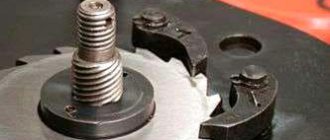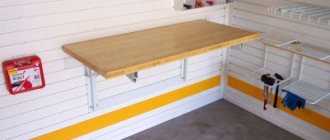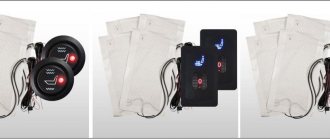The first thing that needs to be made in the garage box after installing the frame and roof is a washbasin for the garage. After all, no one wants to go home with dirty hands after repairing a car or cleaning the carpentry workshop inside the box. In this information material we will look at the 2 most popular options for making a washstand.
The nuances of installing a washbasin in the garage
In order to use the washbasin comfortably and prevent the negative consequences of its installation, including leakage, a number of nuances should be observed. In particular:
- the sink should not protrude beyond the wall structure at the entrance to the garage for free opening and closing of the gate;
- if you plan to use the washstand on rare occasions, it is enough to use a bucket to drain;
- the installation site of plumbing must be carefully sealed to prevent liquid leakage;
- It is important to conveniently position the equipment so as not to create obstacles for vehicle passage.
Types of washbasins
You can make a washbasin for the garage from scrap materials or purchase a ready-made design . The simplest option is a homemade design made from a plastic container and wire. Having secured the structure to the wall, you will need to periodically pour water into it, and a regular bucket will be used to drain it. The homemade variety must meet the following requirements:
- ease of installation using available tools;
- use of budget materials;
- sufficient sink volume for hygiene procedures;
- safety (absence of electrical equipment and non-insulated contacts near the washbasin);
- the presence of an additional hole for adding water without using a pump;
- thoughtful design of the locking mechanism.
Article on the topic: Where did frame houses come from?
You can also purchase a ready-made sink and connect it to a homemade drainage system. Pipes for draining water can be taken outside the premises at a distance of several meters from the entrance. There you can dig a hole and cover it with a small homemade lid made of wood or metal. This type of washbasin is suitable for installation in a garage on a country or summer cottage.
More convenient to use is a standard sink, which requires connection to utilities. If pipes for draining water are connected to the garage, all that remains is to buy a washbasin that suits your own wishes and connect it according to the standard circuit, the same as in residential buildings.
General information about portable washbasins
When we are at the dacha or doing “dirty” work in the garage, it is very important to take care of hygiene. Of course, the presence of running water greatly simplifies all procedures, but if it is not there, it is worth thinking about how we can at least wash our hands and wash ourselves.
Washstands are almost always used for these purposes. Today, a relatively small number of models of such products can be found on sale: with the development of the water supply network, they are becoming less and less popular, and therefore the demand for them is predictably falling. And the quality of most of them leaves much to be desired.
Note! The only exception is the professional and semi-professional varieties for camping, but they have another drawback - a very significant price.
As for a homemade washstand, it is desirable that it meets the following requirements:
- Easy to make with your own hands.
- Using inexpensive materials (preferably available ones).
- Volume sufficient for hygiene procedures.
- Ease of use (provided by a well-thought-out design of the locking mechanism).
- Safety (must not contain toxic components, sharp edges, uninsulated electrical circuits, etc.).
All the models presented below, to one degree or another, have the qualities listed here. Let's figure out how to make them.
Where to place a sink in the garage
When developing a garage project, the location for the car and the inspection hole are designated in the center of the room. There should be at least 2 m on each side of the car for comfortable use of the space. To install a washbasin, you often need to free up additional space. By allocating a small space in the corner of the building, you can make a full-fledged washbasin. Corner placement provides the following advantages:
- you can install a hole with a drain pipe to drain dirty water outside;
- plumbing will not create inconvenience for passage indoors;
- The ventilation hole located in the lower corner can be combined with the drain.
If utility lines are connected to the building and they are located in the central part of the wall, it is allowed to install plumbing away from the corner. In this case, it is necessary to provide a convenient approach to the washstand and make sure that it does not create obstacles to free movement.
Chimney outlet through the roof
Diagram of the outlet of a stove chimney for a garage through the ceiling/roof:
As in the case of installing a chimney through a wall, when installing through a ceiling, preliminary assembly is first done in order to accurately mark the future passage through the roof. Once the installation hole is made, the steel penetration through the roof is installed.
Next, in the same sequence, the pipe is assembled and the passage through the roof is laid with non-combustible material. The passage of the chimney through the roof requires reliable waterproofing so as not to encounter leaks in the future. As in the first option, you should protect the pipe from moisture getting into it and insulate the outer part of the pipe to reduce the formation of condensation.
How to install correctly
Features of the installation process depend on the type of sink chosen. If you want to make a washbasin from scrap materials, you need to fix a container on the wall, and build a drainage system from plastic pipes. The water drain can be drained into a bucket or out through the ventilation opening. For external drains, securely secure the pipes, but do not completely cover the vent. This is necessary so that the pipes do not move when water moves inside them, and fresh air passes into the room through the remaining hole.
Article on the topic: How to calculate bricks for a garage
To prevent a hand-installed washbasin from splashing cold and hot water onto the walls of the garage, it is recommended to stick tiles or use other moisture-resistant material in the work area.
You can use a wooden stand or basket as a shelf for storing soap accessories, towels, tools and other things.
For convenient use of the washbasin, you should also attach a lighting fixture next to it. In everyday conditions, it is enough to make a light source by carrying it from the nearest outlet.
A more thorough model of a country washbasin: step-by-step instructions and photos
Here boards were used for cladding
If you don’t mind spending time and effort, you can start making a more solid design for a country washbasin with your own hands, called “Moidodyr”. It includes a cabinet and a separate area for placing a water tank. Building materials can be purchased or used those that are freely available on the site. The complementary elements are the sink and tank. Thrifty summer residents usually use a washbasin that was dismantled during repairs and make the cistern themselves. The model is universal, as it is suitable for installation outdoors and indoors.
A washbasin with a cabinet is a frame covered with sheet or panel material. It could be:
- plywood;
- Fiberboard;
- chipboard;
- Sheet steel;
- plastic;
- polycarbonate;
- polymer panels.
It is quite possible to sheathe the frame with boards. Specifically, for the frame you will need wooden blocks with a section of 50 by 80 mm, or a steel corner measuring 25x25 mm.
The frame consists of bars that are sheathed with sheet material
Sequence of further actions:
- Take accurate measurements of the sink and, based on them, calculate the dimensions of the cabinet base.
- Cut the blanks for the frame to the required dimensions: 8 pieces of the same length (to create the upper and lower square horizontally) and 4 vertical bars.
- Assemble the structure by knocking or welding, depending on the type of material.
- Cover the frame with cladding material on all sides, except for the front.
- Attach the doors to the front.
- On top, as a continuation of the rear wall, build a panel for attaching the tank.
At this point the construction work can be considered completed. All that remains is to install a bowl for washing and a storage container for water.
Arrangement of the garage. Part 1. Washstand.
Since I do a lot of work on the car myself in the garage, I needed to wash my hands somewhere after working on the car, so I bought an ordinary rural washstand in the epicenter.
I decided to share with you how you can wash your hands, etc., as cheaply and conveniently as possible. in the garage. Below I will give an example with prices and photos of the process.
In general, as always, to make it clear











